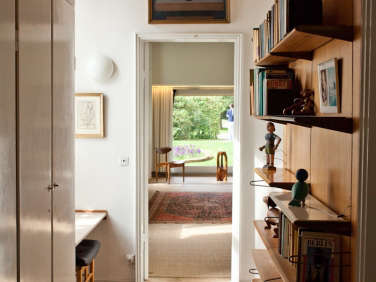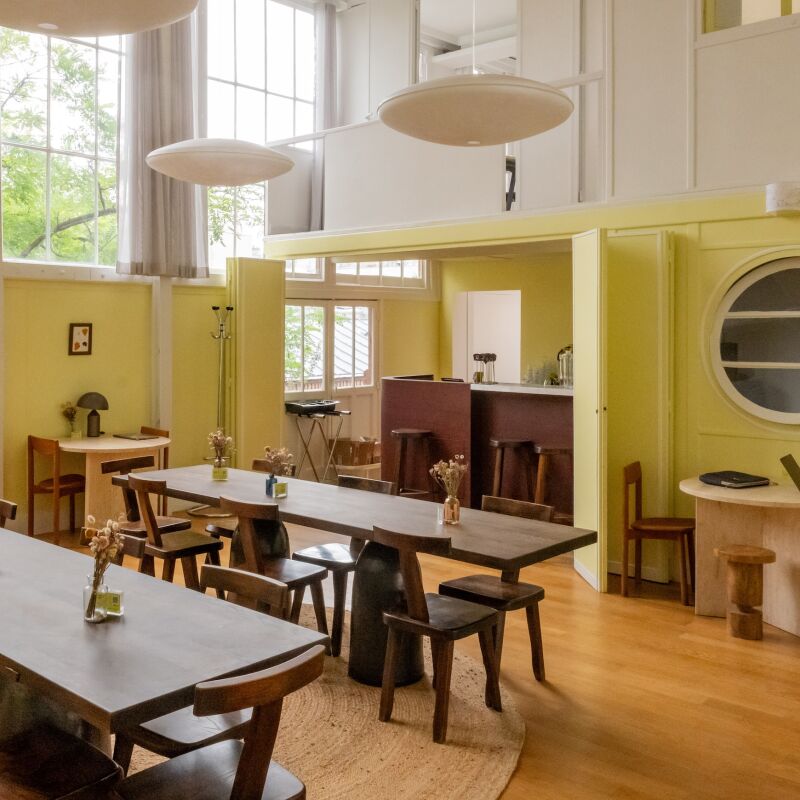It was the old-fashioned details that hooked me when I first spotted Bovina Farm & Fermentory on Instagram: a hanging Shaker basket, tall beeswax tapers, handwritten menus, and stenciled motifs on the walls.
What I didn’t yet realize is that these were only the (spot-on) finishing touches of a ground-up project by the farm’s owners, Elizabeth Starks and Jacob Sackett. Not a rambling old barn and homestead, as I assumed, the property was designed and built by the pair to serve as their home and as a communal gathering space of sorts. “The vision was a homestead that would serve us as a living space, a working space for growing food and raising animals, and a space to welcome in visitors,” Elizabeth writes. “We saw old farms that functioned in this way while living abroad in the Czech Republic for a school semester and just fell in love with that version of home.”
The project was a homecoming for the couple: “Jake is a Catskills native; his family dates back to the early 1800s in the neighboring town of Bloomville,” writes Elizabeth. She herself is from the Hudson Valley, and the two met during their first year at Cornell. “We actually glazed over this parcel for a long time before we decided to drive over and check it out,” Elizabeth adds. “We hiked up the hill along an old rock-wall bordering the cow pasture and found a large flat area at the top with a natural spring running through the woods. We saw the views running down the valley in both directions. I think we made an offer later that week.”
Elizabeth’s father (who had built his own house 30 years prior) “dusted off the architecture books,” as Elizabeth says, to help create blueprints from ideas they’d collected over the years. “A builder on the other side of the mountain constructed our timber-frame barn and the house structure,” says Elizabeth, “and we finished the interior ourselves.” The couple has also “added a root cellar into one of the smaller hills, started an orchard behind the house with eleven fruit trees, built a chicken coop and duck house with a pond, and are planning for the addition of dairy sheep this fall.
“We hadn’t done any of this before, so it was a lot of figuring it out as we went,” adds Elizabeth. “Neither of us have backgrounds in cooking or design, which perhaps is where our very simple approach to both comes from. We both spent our childhoods playing out in the garden or in the woods. We developed a true appreciation for that first garden snap pea each year, the wild raspberry patches, roadside wildflowers, fish from the backyard stream, and luckily had parents who fostered an eye for seeing the beauty in these simple, good things.”
Now, the homestead houses a newly opened dining area and a small market and is open to passersby for a slices of pie or a house-made beer, brewed in the barn. Upstairs are the couple’s own living spaces and—soon—an inn.
Join us for a look at some of our favorite details.
Photography by Christian Harder (@christianharder).
1. Choose folding pieces.


2. Think simple + useful.

Because there’s no attic and no basement, there’s little spare storage space. “Living with all of your things out around you as part of your space translates into utilitarian furniture and decor that is both beautiful and useful. Of course we do also have special keepsakes and heirlooms stashed around the house purely for the joy they bring.”
3. Use evocative neutrals.

4. Add tiny notes of summer.

5. Rethink stencils.

6. Leave floors bare.

7. Bring back vintage wallpaper.

8. Sleuth for Shaker finds.

Pictured is the couple’s private kitchen, upstairs. “The cabinets are from deVol’s Shaker range, painted in their Mushroom color,” Elizabeth says. “The sink is a Villeroy & Boch farmhouse sink with deVol’s Brass Mayan Taps. We cut a small piece of marble and fit it under the taps for extra durability in the wet area around the sink and built the shelving ourselves, mixing peg rails with corbels and a plate rack to maximize dish storage. And we found white oak butcher block countertops and left them mostly raw—there is one coat of a natural matte finish from Vermont Natural Coatings.”
9. Embrace yellow.

10. Hang it up.

11. Give shades a makeover.

Another wall-mounted foldaway: “The Danish scissor/accordion wall lamp in the bedroom is a vintage fixture from Etsy,” says Elizabeth. “We also have a similar fixture downstairs in an office/library room. We love that it can be extended outwards or folded away, just like the wall-mounted folding desk that it hangs above.”
12. Nothing beats rocking chairs.

13. Install screen doors.

14. Unplug.

N.B.: “Currently, friends and family have a hold on the guest room,” notes Elizabeth, “but the plan was always to offer the house as a place to stay in addition to opening the downstairs with homemade food and drink. We’ll be opening the second floor to the public in the near future.” Keep an eye out.
And for more in the Catskills, see:
- Upstate Update: A Writer’s “Layered,” Eclectic Catskills Farmhouse, Three Years In
- The Reset Club’s Cook House, a Chic Catskills Rental, Resources and Remodeling Advice Included
- Head for the Hills: Two NYC Architects Design Their Own Passive House, Vipp Kitchen Included








Have a Question or Comment About This Post?
Join the conversation